Upper Body Workout for Runners
- October 17, 2022
- Last Updated: April 3, 2024
- 0 Comments
- Running
This upper body workout for runners includes modifications for dumbbells and bands. You can do most of these arm exercises for runners in your own home to stay toned and strong.
As an Amazon Associate, I may earn from qualifying purchases. You can read more here on our Disclaimer and Privacy Page.
As a NASM-Certified Personal Trainer, I wanted to put together this upper body workout for runners that includes some arm workouts for runners for those interested in cross training.
We all know that only running can lead to injuries, right? We have to include adequate rest and recovery (to avoid RED-S), and hopefully some body weight training or strength training alongside our endurance training.
Along with practicing rest and flexibility, eating enough protein and calcium for runners can make a big difference in strength and bone health.
We also want to do the things we don’t always want to do, like foam rolling for runners, to protect our joints and bones and decrease the risk of injury.
Protein shakes for runners come in handy after a workout!
So, today, we’re going to share an upper body workout for runners that focuses on key areas for strength and injury prevention.
And additionally, pairing strength exercises with foods high in leucine can help with muscle building, too!
Want your running nutrition questions answered?
Fill out this form to be matched with one of our dietitians.
In This Article
Why is an Upper Body Workout for Runners Important?
When you think of running, chances are you probably think about lower body movement. After all, your feet and legs carry your body forwards.
But, if the lower body does all of the work, then why do the arms move?
Truthfully, most runners don’t know why, and as a result, they don’t prioritize upper body strength.
Upper body movement is a highly integral component of good running technique, and can be an act of self care for your body.
After all, momentum from the arms swinging helps to lift the body off of the ground, and the resulting rotation through the abdominal region balances the lower body’s alternating strides.
If we continue to view arm movement while running as inconsequential to the overall movement, we will miss out on a potential opportunity to improve running speed and efficiency.
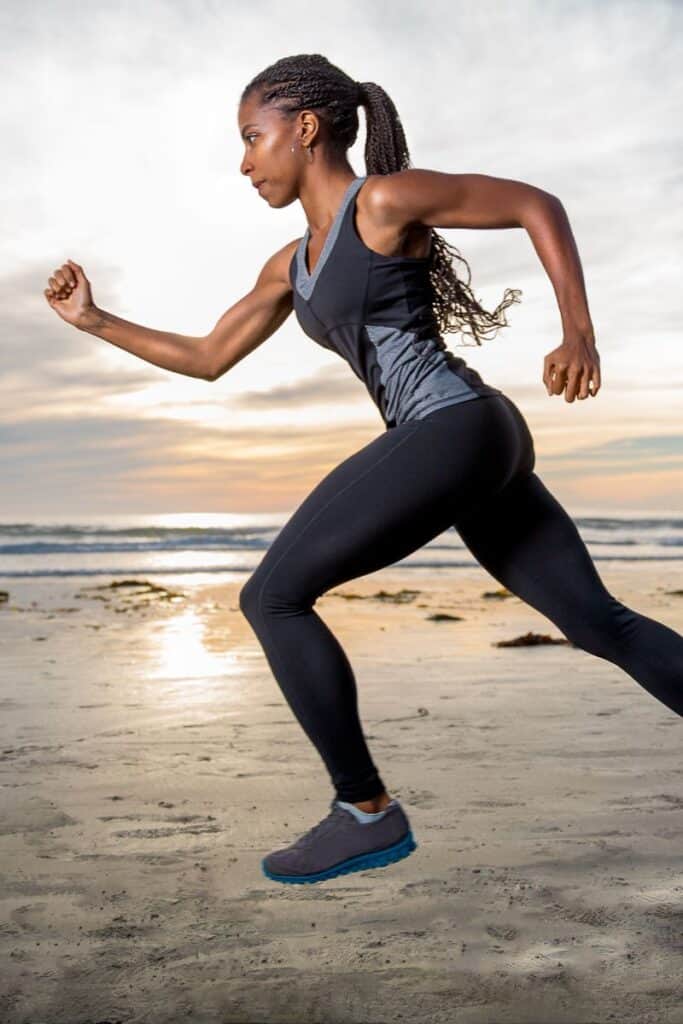
Equipment Needed
If you’re trying to complete this upper body workout for runners, here’s what we recommend having on hand.
- A solid dumbell set
- Bands – These are great in place of dumbbells sometimes or if you have injury or lack of range of motion. Resistance bands are great to keep around. They also make for a great stocking stuffer for runners!
- Bench
Running Form and Arm Swing While Running
In order to fully appreciate the importance of arm movement in running, it’s helpful to understand what happens to running form and efficiency when the arms become fatigued.
First, the arms drop, meaning the elbows lose their bend. From here, the arms swing less, meaning the upper body contributes less momentum to the overall movement.
On top of this, crossing over, which happens when the wrists come closer to the body’s midline, starts to occur.
All of these changes combine to decrease running efficiency, which means you’re wasting energy and finishing with slower times.

So, what should we do to improve arm swing?
The best way to improve arm swing while running and protect the integrity of arm movement in running is to prioritize strength training.
Doing so will prevent fatigue and muscle imbalance, which not only improves the athlete’s movement but also decreases the risk of injury.
But before we get into what strength training should look like for runners, let’s zoom out and take a look at strength training as an overall concept.
Why Strength Training for Distance Runners Counts
Most runners disregard strength training because their success depends mostly on cardiovascular fitness and muscular endurance.
And to an extent, they’re picking up on a valid point. Almost all strength training affects type II fibers, which mostly benefit quick, powerful movements. Creatine for runners can help with this!
On the other hand, distance running relies on type I muscle fibers, which are less involved by most strength training.
However, this discrepancy doesn’t mean that runners shouldn’t strength train, only that they should choose appropriate movement patterns, repetitions, and load for their sport.
Strength training can be catered to four different goals:
- power
- strength
- hypertrophy
- muscular endurance.
Of these, power and strength involve the least repetitions with the greatest load, and muscular endurance involves the greatest repetitions with the least load.
Especially since the role of the arms in running is to sustain a steady swinging motion while the legs propel the body forward, our upper body workout for runners will be focused on muscular endurance.
People also often ask about collagen for running and strength.
The post goes into more detail but for the most part, collagen won’t help build strength or muscle, but may have joint benefits.
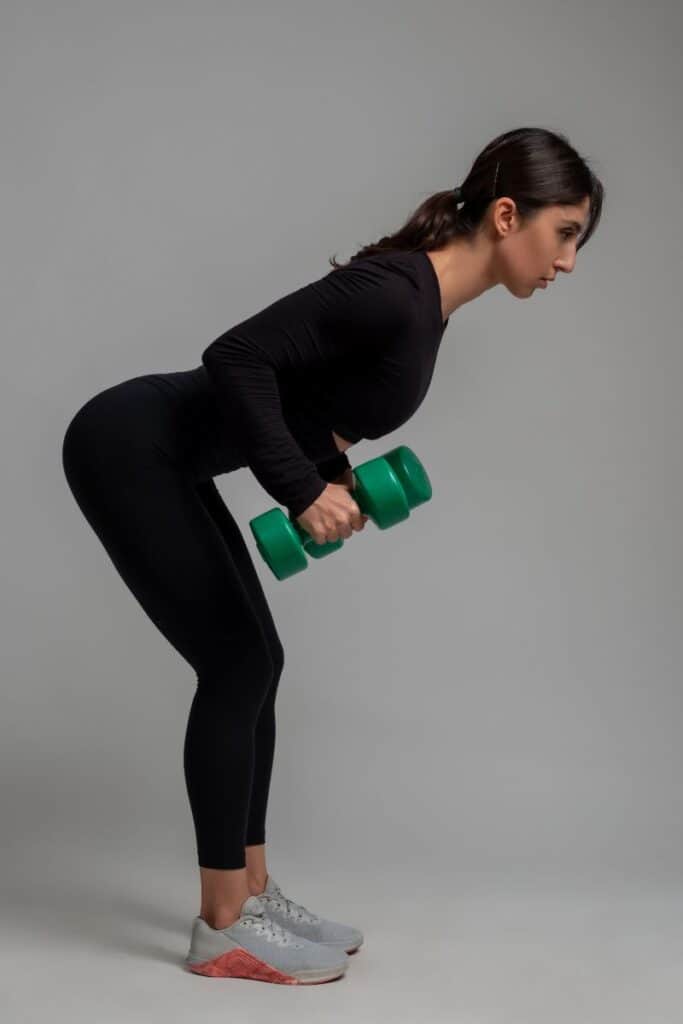
Strength training as a form of cross training can also take some of the impact off of the running muscles and work on accessory muscles.
Mentally, it may also help with runners burnout or marathon training burnout.
6 Upper Body Exercises for Runners
The following runners arm workout focuses mostly on the upper body. Upper body exercises for runners are important, as we have previously discussed.
The upper body can be divided into muscles that perform pushing movements (chest, shoulders, and triceps) and muscles that perform pulling movements (back and biceps).
Arm swinging while running is caused by a pushing movement, so the shoulders and triceps are responsible for most of the work.
However, the back and biceps should also be strengthened in order to prevent muscle imbalance and support healthy posture while running. The following six movements combine these goals into a single upper body workout for runners.
For best results, perform 2-3 sets of 15 repetitions of each movement, and choose a weight that is challenging but doable without compromising form.
For best results, perform 2-3 sets of 15 repetitions of each movement, and choose a weight that is challenging but doable without compromising form.
HOPE PENNER, CPT
1. Dumbbell Front Raise
Why we do it:
The dumbbell front raise works the anterior deltoids, which are located on the front of the shoulder. Even more, the anterior deltoids perform a front raise in the same plane as the arms swing while running.
In other words, the strength built through this exercise will directly help the arms to continue producing momentum.
How to do it:
To perform a front raise, stand with the feet shoulder-width apart and grab a pair of light dumbbells—try starting with 5 lbs—placing one in each hand. Position the dumbbells just in front of the thighs, palms facing the body, with hands about shoulder-width apart.
With elbows straight but not locked out, raise both arms at the same rate until they are parallel with the floor, palms still facing down. Lower the dumbbells back down to the starting position and repeat until you reach 15 repetitions.

To build a more well-rounded shoulder, you can also incorporate dumbbell lateral raises, which work the lateral deltoids and help perform lifting motions to the sides of the body.
To perform a lateral raise, keep the same posture and arm position as a front raise, but start with the arms at the sides and raise the dumbbells to the sides, not to the front.
2. Seated Cable Rows or Dumbbell Bent-Over Row
Seated cable rows work prominent muscles of the back, like the latissimus dorsi and rhomboids.
Why we do it:
While these muscles aren’t actively creating momentum during running, like the anterior deltoids are, they’re responsible for supporting healthy posture, which allows the body to perform any activity more efficiently.
Most cable machines have various handles that can be swapped out, but use the seated row handle for the best activation here. This attachment will position the hands with a fairly narrow grip, palms facing each other.
How to do it:
To set up for a seated cable row, choose the appropriate weight on the cable machine, then sit on the bench, facing the cable machine.
Place your feet onto the foot supports while maintaining a soft bend in the knees—this set-up will allow you to stabilize the rest of the body while you work through the back.
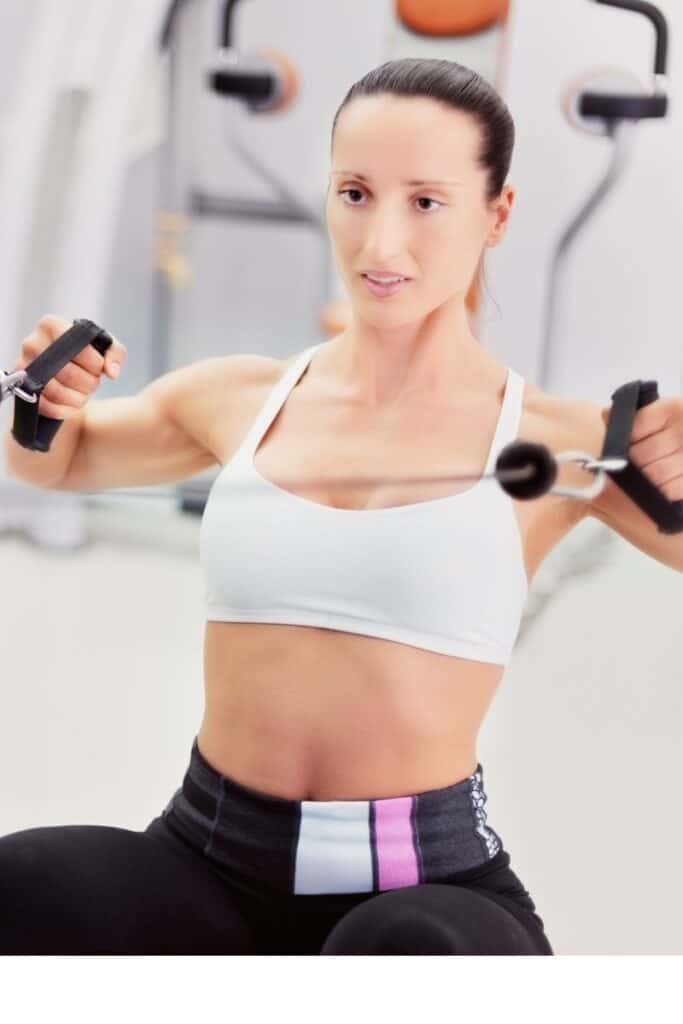
From here, lean forward to grab the handles with palms facing each other, then position the torso upright or slightly leaned back. To perform the movement, use the back muscles to pull the handle to the belly button, keeping the shoulders rolled back and elbows pointed down, not out to the sides.
Once the handles reach the torso, slowly release the lift by straightening the arms, then repeat.
Throughout the movement, keep the core tight, and avoid jerking the torso to move the weight. If you find yourself compensating like this, reduce the weight you’re lifting.
If you don’t have access to a cable machine, you can still work your back—just substitute a dumbbell bent-over row for these seated cable rows.
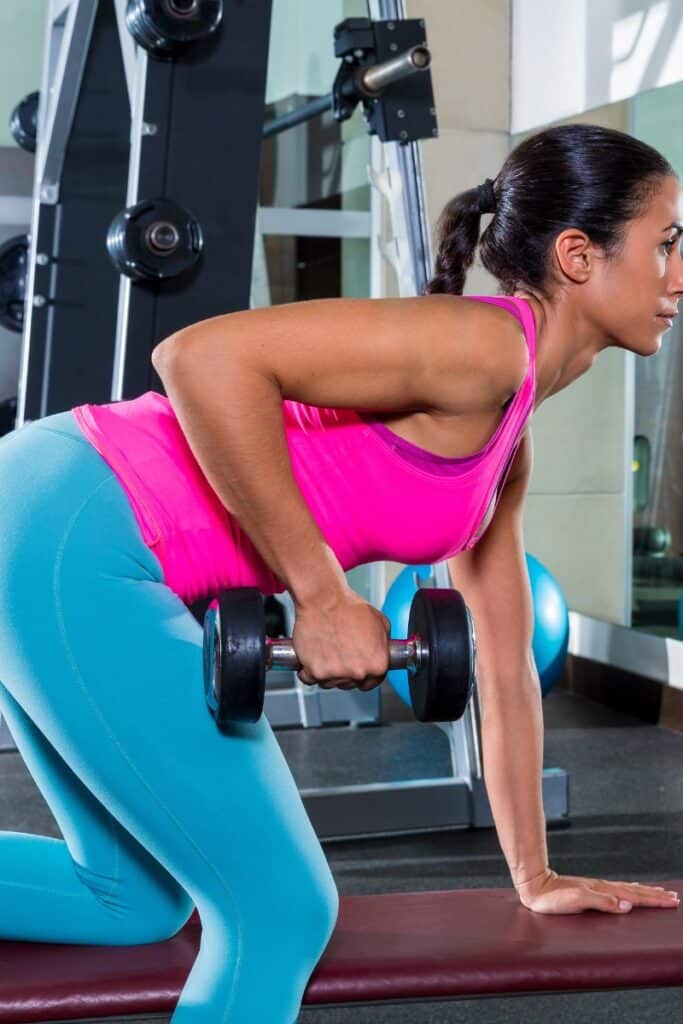
3. Triceps Kickbacks
Like the name implies, triceps kickbacks work the triceps, which are located on the back of each arm.
Why we do it:
The triceps partner with the anterior deltoids to push the arm swing in running, so triceps endurance is key to making sure the arms don’t tire out.
How to do it:
For a triceps kickback, stand with the feet shoulder-width apart and hold one dumbbell in each hand, with the arms at the sides and palms rotated towards the thighs.

Roll the shoulders back and hinge at the hips, keeping the back flat. From here, bend the elbows at a 90-degree angle with the elbows tucked into the sides of the body.
To perform the movement, keep the upper arm stationary, but push through the back of the arm to extend the elbow until it is straight. Lower the arm with control until the elbow is back at 90 degrees, and repeat.
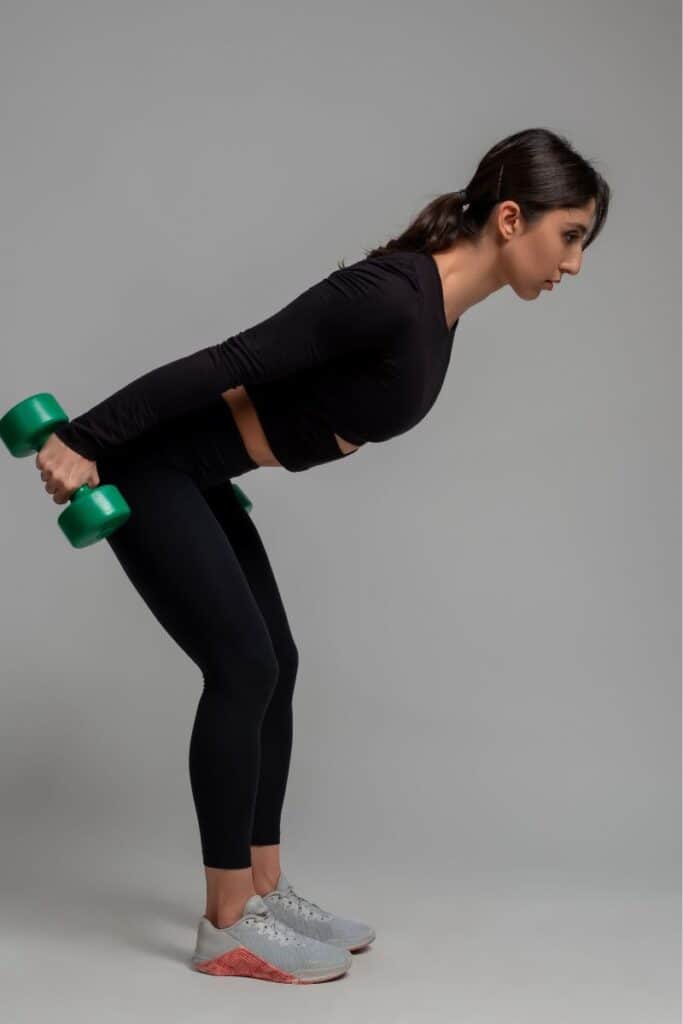
4. Dumbbell 21s
The name of this exercise might seem a little puzzling, but “21” refers to the amount of reps you’ll complete per set. So, for this exercise only, we’ll let go of our go-to number of 15 reps per set.
In actuality, dumbbell 21s are a biceps exercise. While most people normally increase load for biceps exercises, since the biceps are relatively strong muscles of the upper body, I would recommend keeping the weights lighter in order to allow for such a high rep count.
Why we do it:
I love dumbbell 21s for runners because they exhibit joint angle specificity.
Joint angle specificity is the idea that the strength and coordination gained from performing an exercise will translate to other athletic movements involving the same joint being worked at the same angle.
In this case, dumbbell 21s work in, through, and around the same angle that the elbow remains at while running, so this exercise can improve the body’s ability to hold that arm position for longer.
How to do it:
For this exercise, choose a relatively light set of dumbbells, and stand with the feet shoulder-width apart.
The first component of the exercise is to perform seven biceps curls through the bottom half of the movement, meaning you curl the weight until the elbow is at 90 degrees, then lower back to the bottom of the movement.
After these first seven curls, you’ll perform seven curls through the top half of the movement.
Start with the elbows bent at 90 degrees and curl until the elbows are fully flexed with dumbbells near the shoulders, then lower back to 90 degrees.
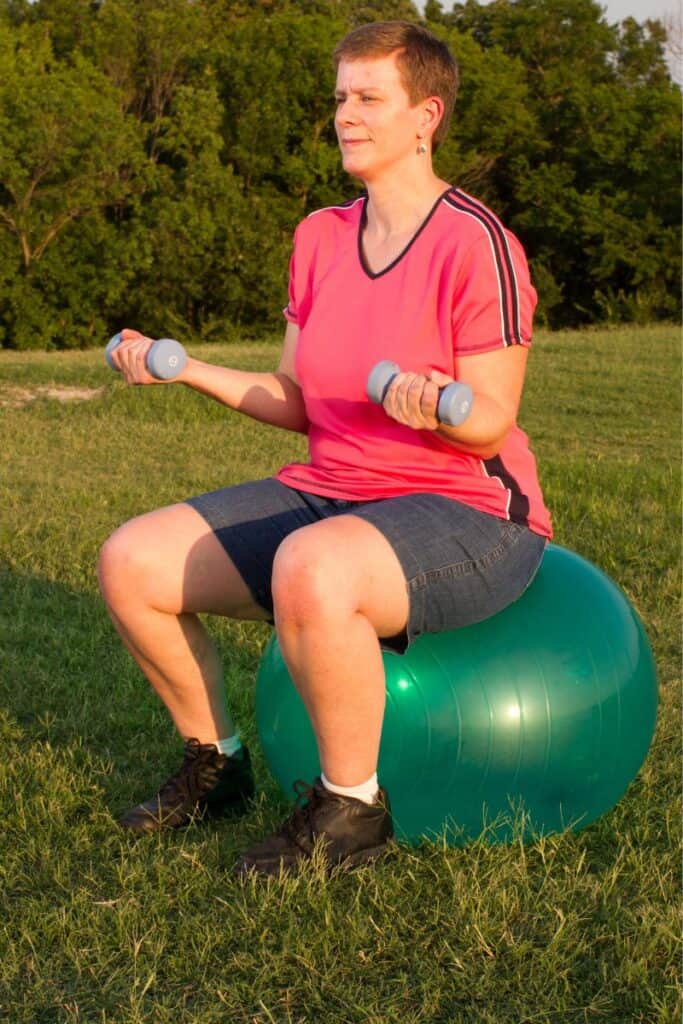
Lastly, perform seven curls through the full range of motion, starting with the elbows fully extended, to fully flexed, back down to fully extended.
If at any point, you find yourself compromising form or pushing the hips forward to complete the movement, consider reducing your weight.
You’ll build strength more effectively by completing the exercise with integrity through the torso than by cheating.
5. Inchworms
Why we do it:
Inchworms emphasize not only upper body strength but also upper body and core stability, all of which are important for runners.
How to do it:
To perform an inchworm, start in a full plank, with the hands directly under the shoulders and the body making a straight line through the torso and hips down to the feet.

From here, slowly walk the feet into the hands, keeping the palms grounded into the floor and the knees straight.
Once you cannot walk the feet any closer to the hands, walk the hands forward until you reach a full plank, and repeat.
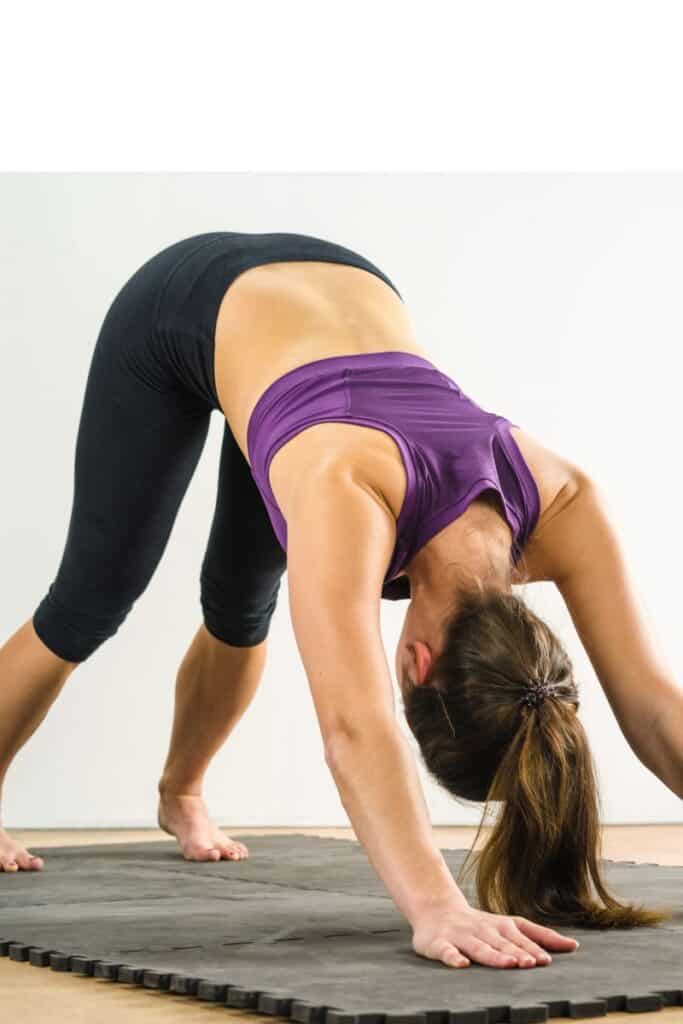
If you’d like to add some chest work to the movement, you can perform a push-up every time the body reaches a full plank.
While the chest is not greatly involved in running, strengthening the chest is still important in order to prevent muscle imbalances.
If you’re doing most of these exercises correctly, they become core and upper body workouts for running, too.
6. Dumbbell YTs
Why we do it:
Dumbbell YTs are a combination of two movements—a Y raise and a rear delt fly—that emphasize stability in the upper back.
If these muscles are week, posture while running will be compromised more quickly.
How to do it:
For a YT, set a bench to an incline of 45 degrees, and sit facing the bench, leaning forward and letting the chest to be supported by the bench. With a light dumbbell in each hand and the elbows softly bent, raise the arms until the dumbbells are overhead and slightly outside the shoulders, resembling a Y shape.
Lower the arms back to the sides, then pull the shoulder blades back to move the arms out to each side of the body, reaching a T shape. Lower the arms back to the sides to complete one repetition.
Since the YT is a two-step movement, try starting with 10 full reps, and eventually work up to 15 reps.
Always make sure to refuel properly – check out these healthy athlete snacks for post workout. While you may choose to supplement with BCAAs, know that they are not enough calories and fuel to support your activity.
Treadmill Workouts for Runners
You may want to check out some of these treadmill workouts for runners, too!
- Pyramid workout for runners
- Postpartum running workout (building back endurance)
- 60 Minute Speed Interval Workout
- 30 Minute At Home Circuit Workout
- How to Get More Movement Into Your Day
References:
Haff , G. Gregory , Triplett , N. Travis. (2015). Essentials of Strength Training and Conditioning. (4th ed.). Human Kinetic Publishers.
Support Bucket List Tummy









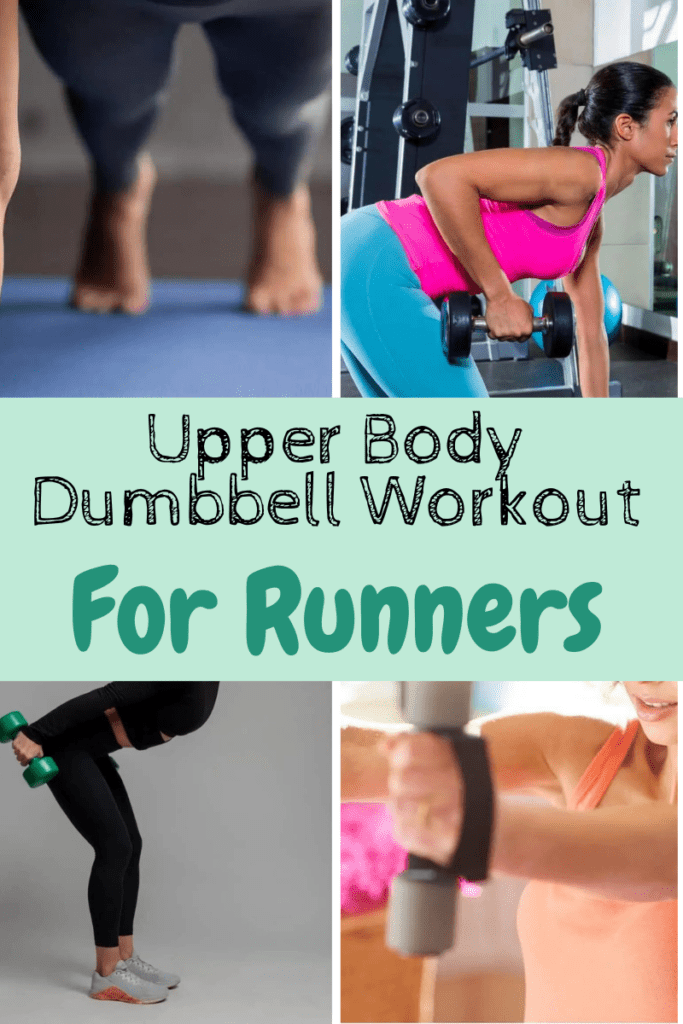
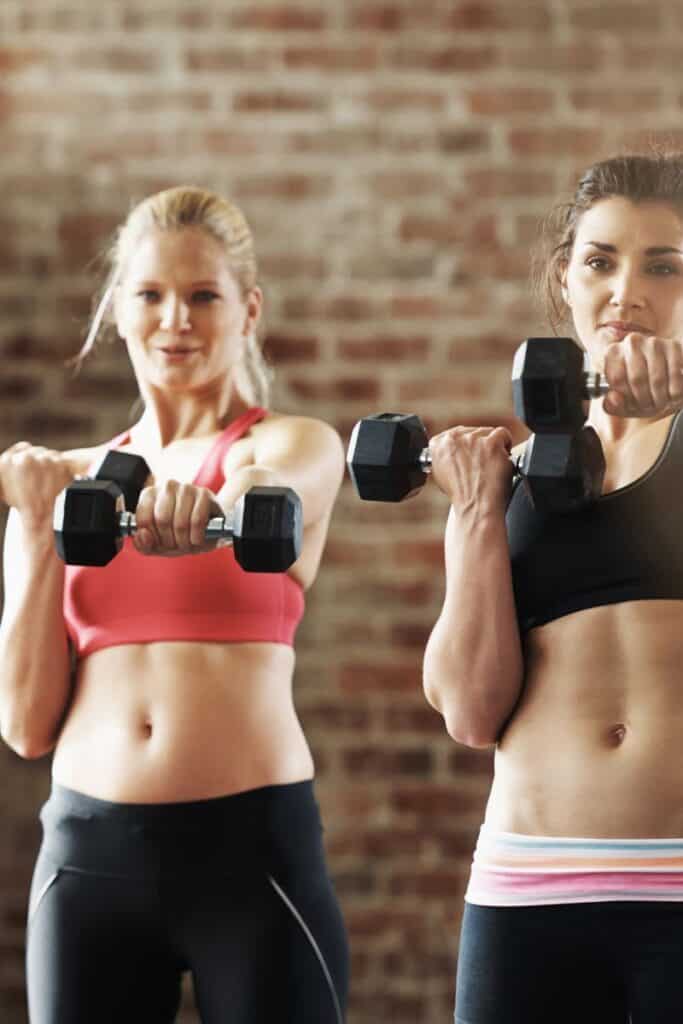














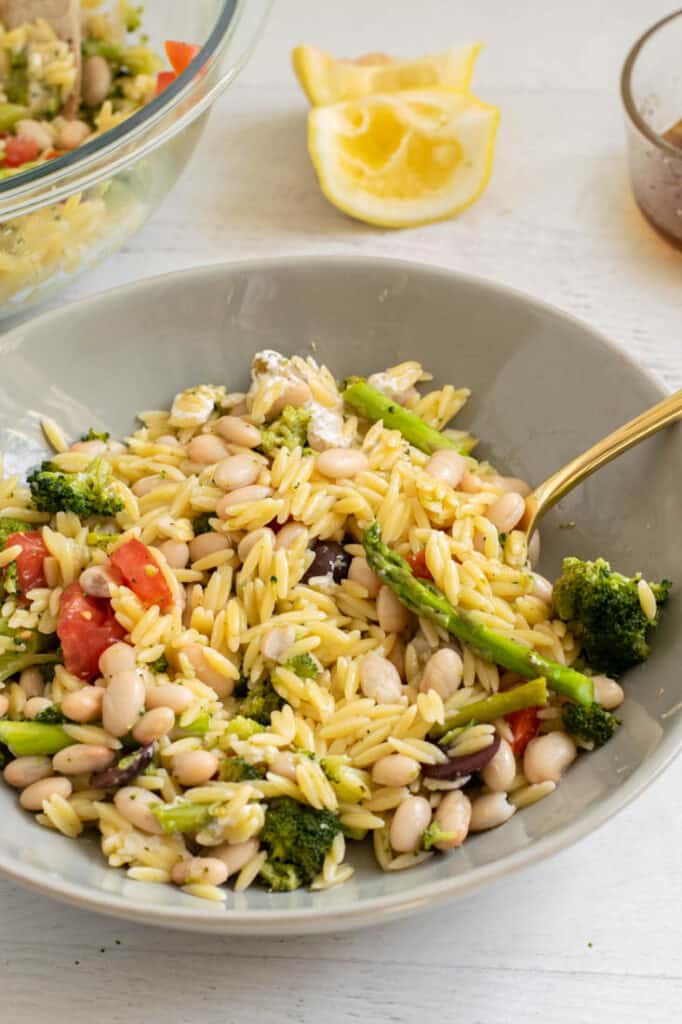



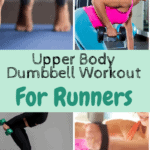
Like This Content?
Support Bucket List Tummy